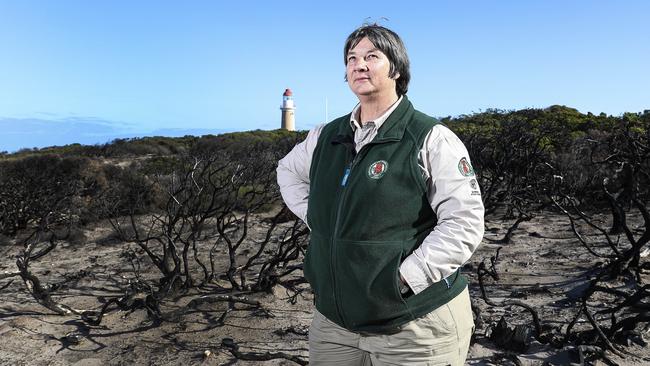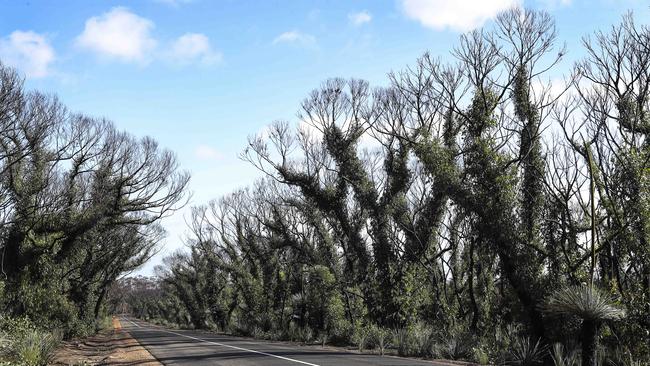Flinders Chase National Park to reopen on Saturday, six months after Kangaroo Island bushfires
It’s been a tough six months recovering from devastating bushfires, but Kangaroo Island will mark a major milestone on Saturday when Flinders Chase National Park reopens to the public.
SA Weekend
Don't miss out on the headlines from SA Weekend. Followed categories will be added to My News.
Six months ago, fire gutted the two places Alison Buck held most dear.
The family home she had shared with husband Bruce for nearly 30 years went up in flames in the January 3 fireball which engulfed the western half of Kangaroo Island.
The inferno also destroyed 96 per cent of Flinders Chase National Park, where Mrs Buck has worked for almost 25 years, reducing much of it to ash.
Needless to say, the past six months have been an emotional experience trying to rebuild both her home and her workplace.
“It’s always ups and downs,” she says. “You’ll have a really good day and the something will trigger you off.
“There’s a video on the (National Parks and Wildlife Service) website about the Flinders Chase coming back and the recovery – and that always makes me cry.”

There’s still a long way to go, but things are now starting to look up.
Mrs Buck now has power, a shower and a flushing toilet at the makeshift accommodation on her Gosse district property, and plans are afoot to rebuild. And on Saturday, the 32,000ha Flinders Chase National Park reopens to the public.
Locals hope the move will create a much-needed boost for the island’s tourist industry which had been just starting to recovery from the bushfire that destroyed or damaged 119 homes and burnt more than 200,000ha when COVID-19 restrictions kept visitors away for months.
Although the park is a far cry from the carpet of green it usually provides this time of year, six months of regrowth on its charred remains offers people a unique chance to see nature on the rebound.
Walking trails, picnic areas and the park’s wilderness trail remain closed, but from Saturday the park’s southwest corner, which boasts features including Remarkable Rocks, Weirs Cove, Admirals Arch and Cape de Couedic Lighthouse will be accessible.
Mrs Buck, wilderness trail manager, said the natural rejuvenation was similar to what had occurred after a previous blaze in 2007. This summer’s fire, though, caused more infrastructure damage – including the loss of the visitor information centre.
“After the fire, one of the first things that comes back is the yakkas, the xanthorrhoeas – they’re amazing,” she says. “They’ve got a really strong root system underneath the ground … and above the ground you usually end up with a core of unburnt stuff in the middle. As time goes on, that spreads.

“The grass skirt, which burns off in the fire, is starting to come back. And then you’ve got the flower spikes coming up, and they grow in all different shapes.
“They provide food for the honeyeaters; they’re the first thing that come back, and flowers in the park. So, the native insects such as the bees, the honeyeaters and pygmy possums have a new food source.
“And when those yakkas have finished flowering, they’ll die and then the fibrous part inside the main stem becomes home for other insects. It’s a fantastic life cycle.”
Thousands of the park’s blackened trees are also showing signs of regrowth, especially on stringybark trees, where the new growth shoots out from the main trunk and along branches.
Regrowth on sugar gum trees, Mrs Buck explains, is less obvious but still occurring, while mallee trees sprout via underground lignotubers.

The fire has also given rangers a chance to eradicate feral cats through a trapping program which makes the most of the pests being forced to congregate in the small pockets of unburnt areas that are a haven for remaining wildlife.
Flinders Chase reopened for licensed tour operators last month but this weekend will be the first time since January that visitors will been allowed to drive, without an escort, in their own cars.
Environment and Water Minister David Speirs says the reopening is another step in the long journey towards recovery.
“Today is a very exciting day for South Australia, in particular the Kangaroo Island community,” he says.
“The natural environment on Kangaroo Island has undergone some amazing rejuvenation, and the reopening of the park will help provide a boost to the local economy.
“With school holidays just beginning, now is a great time to get over to Kangaroo Island and support the local community.”

Gutted sanctuary reopens
HANSON Bay Wildlife Sanctuary, about 5km east of the Flinders Chase entrance, reopened on Friday for the first time since the fire.
The fires gutted buildings, including the visitor centre and accommodation cabins, and burnt more than 95 per cent of the 200ha sanctuary.
Owner Jim Geddes says staff and volunteers have spent six months cleaning up and preparing to reopen.
Mr Geddes says one of the fire’s few silver linings is that the sanctuary is now home to four glossy black cockatoos, a rare species which had previously been confined to the island’s northern beaches.
“People can come back and do a tour and see all of the wildlife and a lot of the recovery,” Mr Geddes says. “Nature is really coming back.”
Seaport vital to boosting economy
By Michelle Etheridge
A new seaport on Kangaroo Island is the “essential foundation” to enable forestry to recover from the bushfires and would boost its economic resilience, its proponents say.
Kangaroo Island Plantation Timbers’ final response document to public submissions about the Smith Bay proposal has been released, as it awaits news from the State Government about whether the development will be approved.
And the company has been quick to shoot down criticism of the project, which is expected to cost more than $40 million and create about 160 direct and 74 indirect jobs.
It says once operations begin, the seaport would have “a substantial positive economic impact” on KI.
“Even after the fires, the impact would be equivalent to many years of economic growth at current rates,” the company says.
In September, Kangaroo Island Plantation Timbers overhauled plans for the project in response to community concerns, including dropping its solid causeway in favour of a 250m jetty extension to eliminate the need for dredging.
The company says it would stimulate population growth, increase housing demand and make the island’s economy more resilient.
Kangaroo Island Council – among the project’s major opponents – is concerned the port will have a devastating effect on a nearby abalone farm.
The council wants the port to be west of Stokes Bay Rd and closer to the plantations where the water is deeper.
In its submission to the State Government, it said the cost of building and maintaining the council road network was “a deeply serious concern”.
The Transport Department said the company should pay to upgrade and maintain roads servicing its development.
Yumbah Aquaculture has repeatedly said if the seaport goes ahead, it would compromise the viability of its abalone farm because of water temperature and quality changes, increased risk of marine pests and changes to ocean currents.
Other concerns were raised in more than 1300 submissions, including potential threats to animals, including whales and dolphins.
Kangaroo Island Plantation Timbers said Yumbah’s argument that it could not coexist with a seaport was not backed up by its decision to expand near a timber woodchip export terminal in Portland, Victoria.
However, Yumbah says its Nyamat abalone farm site is 4.8km away from the Port of Portland.
The timber company said the council was advocating for the seaport to be developed at “an unspecified site within a marine park, in the most fire-prone part of Kangaroo Island”.
The company also hit back at the Transport Department’s calls for it to pay to upgrade and maintain roads.
“(The department) is arguing private investors in Adelaide should continue to benefit from a government-funded road network but this benefit should not be available outside Adelaide,” the company said.
